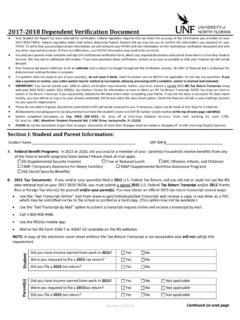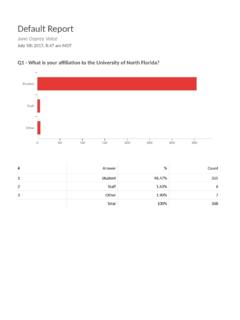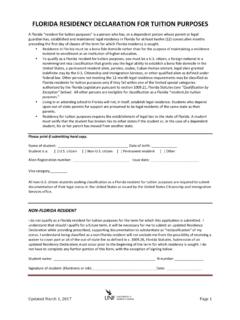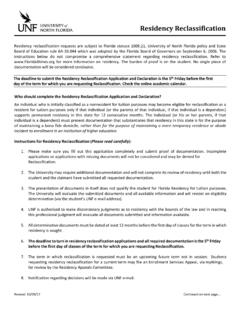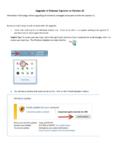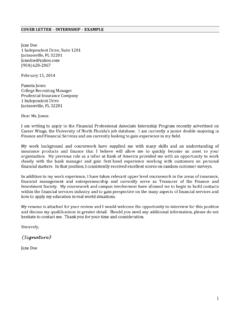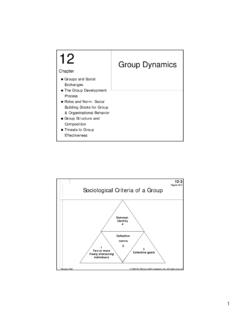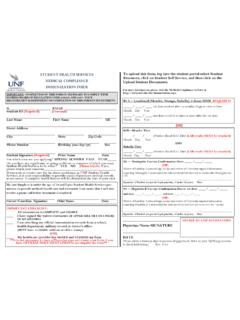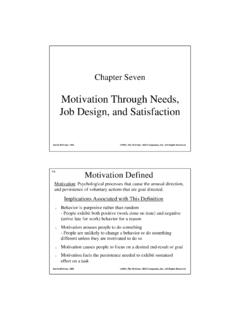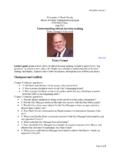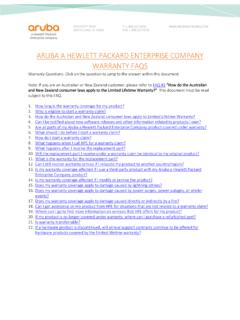Transcription of C Programming Tutorial - University of North Florida
1 C Programming Tutorial i C Programming Tutorial Simply Easy Learning by ii C O P Y R I G H T & D I S C L A I M E R N O T I C E All the content and graphics on this Tutorial are the property of Any content from or this Tutorial may not be redistributed or reproduced in any way, shape, or form without the written permission of Failure to do so is a violation of copyright laws. This Tutorial may contain inaccuracies or errors and tutorialspoint provides no guarantee regarding the accuracy of the site or its contents including this Tutorial . If you discover that the site or this Tutorial content contains some errors, please contact us at iii Table of ContentsC Language Overview .. 1 Facts about C.
2 1 Why to use C ? .. 2 C Programs .. 2 C Environment Setup .. 3 Text Editor .. 3 The C Compiler .. 3 Installation on Unix/Linux .. 4 Installation on Mac OS .. 4 Installation on Windows .. 4 C Program Structure .. 5 C Hello World Example .. 5 Compile & Execute C Program .. 6 C Basic Syntax .. 7 Tokens in C .. 7 Semicolons ; .. 7 Comments .. 8 Identifiers .. 8 Keywords .. 8 Whitespace in C .. 9 C Data Types .. 10 Integer Types .. 10 Floating-Point Types .. 11 The void Type .. 12 C Variables .. 13 Variable Declaration in C .. Error! Bookmark not defined. Variable Initialization in C .. Error! Bookmark not defined. Lvalues and Rvalues in C .. 15 C Constants and Literals .. 17 Integer literals .. 17 Floating-point literals .. 18 Character constants.
3 18 iii String literals .. 19 Defining Constants .. 19 The #define Preprocessor .. 19 The const Keyword .. 20 C Storage Classes .. 22 The auto Storage Class .. 22 The register Storage Class .. 22 The static Storage Class .. 23 The extern Storage Class .. 24 C Operators .. 25 Arithmetic Operators .. 25 Relational 26 Logical Operators .. 28 Bitwise Operators .. 29 Assignment Operators .. 31 Misc Operators sizeof & ternary .. 33 Operators Precedence in C .. 33 Decision Making in 35 if statement .. 36 Syntax .. 36 Flow Diagram .. 36 Example .. 36 statement .. 37 Syntax .. 37 Flow Diagram .. 38 Example .. 38 The Statement .. 39 Syntax .. 39 Example .. 39 Nested if statements .. 40 Syntax .. 40 Example .. 40 switch statement.
4 41 Syntax .. 41 Flow Diagram .. 42 Example .. 42 Nested switch statements .. 43 Syntax .. 43 Example .. 43 iii The ? : Operator .. 44 C Loops .. 45 while loop in C .. 46 Syntax .. 46 Flow Diagram .. 46 Example .. 47 for loop in C .. 47 Syntax .. 47 Flow Diagram .. 48 Example .. 48 loop in C .. 49 Syntax .. 49 Flow Diagram .. 50 Example .. 50 nested loops in C .. 51 Syntax .. 51 Example .. 52 break statement in C .. 53 Syntax .. 53 Flow Diagram .. 53 Example .. 54 continue statement in C .. 54 Syntax .. 54 Flow Diagram .. 55 Example .. 55 goto statement in C .. 56 Syntax .. 56 Flow Diagram .. 56 Example .. 57 The Infinite Loop .. 57 C Functions .. 59 Defining a Function .. 59 Example .. 60 Function Declarations .. 60 Calling a Function.
5 60 Function Arguments .. 61 Function call by value .. 62 Function call by reference .. 63 C Scope Rules .. 65 iii Local Variables .. 65 Global Variables .. 66 Formal Parameters .. 67 Initializing Local and Global Variables .. 67 C Arrays .. 69 Declaring Arrays .. 69 Initializing Arrays .. 70 Accessing Array Elements .. 70 Multi-dimensional Arrays .. 71 Two-Dimensional Arrays .. 71 Initializing Two-Dimensional Arrays .. 72 Accessing Two-Dimensional Array Elements .. 72 Passing Arrays as Function Arguments .. 73 Way-1 .. 73 Way-2 .. 74 Way-3 .. 74 Example .. 74 Return array from 75 Pointer to an Array .. 77 C Pointers .. 79 What Are Pointers? .. 80 How to use Pointers? .. 80 NULL Pointers in C .. 81 Pointer arithmetic .. 81 Incrementing a Pointer.
6 82 Decrementing a Pointer .. 83 Pointer Comparisons .. 83 Array of pointers .. 84 Pointer to Pointer .. 86 Passing pointers to functions .. 87 Return pointer from functions .. 88 C Strings .. 91 C Structures .. 94 Defining a Structure .. 94 Accessing Structure Members .. 95 Structures as Function Arguments .. 96 Pointers to Structures .. 97 C Unions .. 100 Defining a Union .. 100 iii Accessing Union Members .. 101 Bit Fields .. 103 Bit Field Declaration .. 104 Typedef .. 106 typedef vs #define .. 107 Input & Output .. 108 The Standard Files .. 108 The getchar() & putchar() functions .. 108 The gets() & puts() functions .. 109 The scanf() and printf() functions .. 110 File I/O .. 111 Opening Files .. 111 Closing a File .. 112 Writing a File.
7 112 Reading a 113 Binary I/O Functions .. 114 Preprocessors .. 115 Preprocessors Examples .. 115 Predefined Macros .. 116 Preprocessor Operators .. 117 Macro Continuation (\) .. 117 Stringize (#) .. 117 Token Pasting (##).. 118 The defined() Operator .. 118 Parameterized Macros .. 119 Header Files .. 120 Include Syntax .. 120 Include Operation .. 121 Once-Only Headers .. 121 Computed 122 Type Casting .. 123 Integer Promotion .. 124 Usual Arithmetic Conversion .. 124 Error Handling .. 126 The errno, perror() and strerror() .. 126 Divide by zero errors .. 127 Program Exit Status .. 128 Recursion .. 129 Number Factorial .. 129 iii Fibonacci Series .. 130 Variable Arguments .. 131 Memory Management .. 133 Allocating Memory Dynamically.
8 133 Resizing and Releasing Memory .. 134 Command Line Arguments .. 136 TUTORIALS POINT Simply Easy Learning Page 1 C Language Overview This chapter describes the basic details about C Programming language, how it emerged, what are strengths of C and why we should use C. The C Programming language is a general-purpose, high-level language that was originally developed by Dennis M. Ritchie to develop the UNIX operating system at Bell Labs. C was originally first implemented on the DEC PDP-11 computer in 1972. In 1978, Brian Kernighan and Dennis Ritchie produced the first publicly available description of C, now known as the K&R standard. The UNIX operating system, the C compiler, and essentially all UNIX applications programs have been written in C.
9 The C has now become a widely used professional language for various reasons. Easy to learn Structured language It produces efficient programs. It can handle low-level activities. It can be compiled on a variety of computer platforms. Facts about C C was invented to write an operating system called UNIX. C is a successor of B language, which was introduced around 1970. The language was formalized in 1988 by the American National Standard Institute. (ANSI). The UNIX OS was totally written in C by 1973. CHAPTER 1 TUTORIALS POINT Simply Easy Learning Page 2 Today, C is the most widely used and popular System Programming Language. Most of the state-of-the-art softwares have been implemented using C.
10 Today's most ][popular Linux OS and RBDMS MySQL have been written in C. Why to use C? C was initially used for system development work, in particular the programs that make up the operating system. C was adopted as a system development language because it produces code that runs nearly as fast as code written in assembly language. Some examples of the use of C might be: Operating Systems Language Compilers Assemblers Text Editors Print Spoolers Network Drivers Modern Programs Databases Language Interpreters Utilities C Programs A C program can vary from 3 lines to millions of lines and it should be written into one or more text files with extension ".c"; for example, You can use "vi", "vim" or any other text editor to write your C program into a file.
